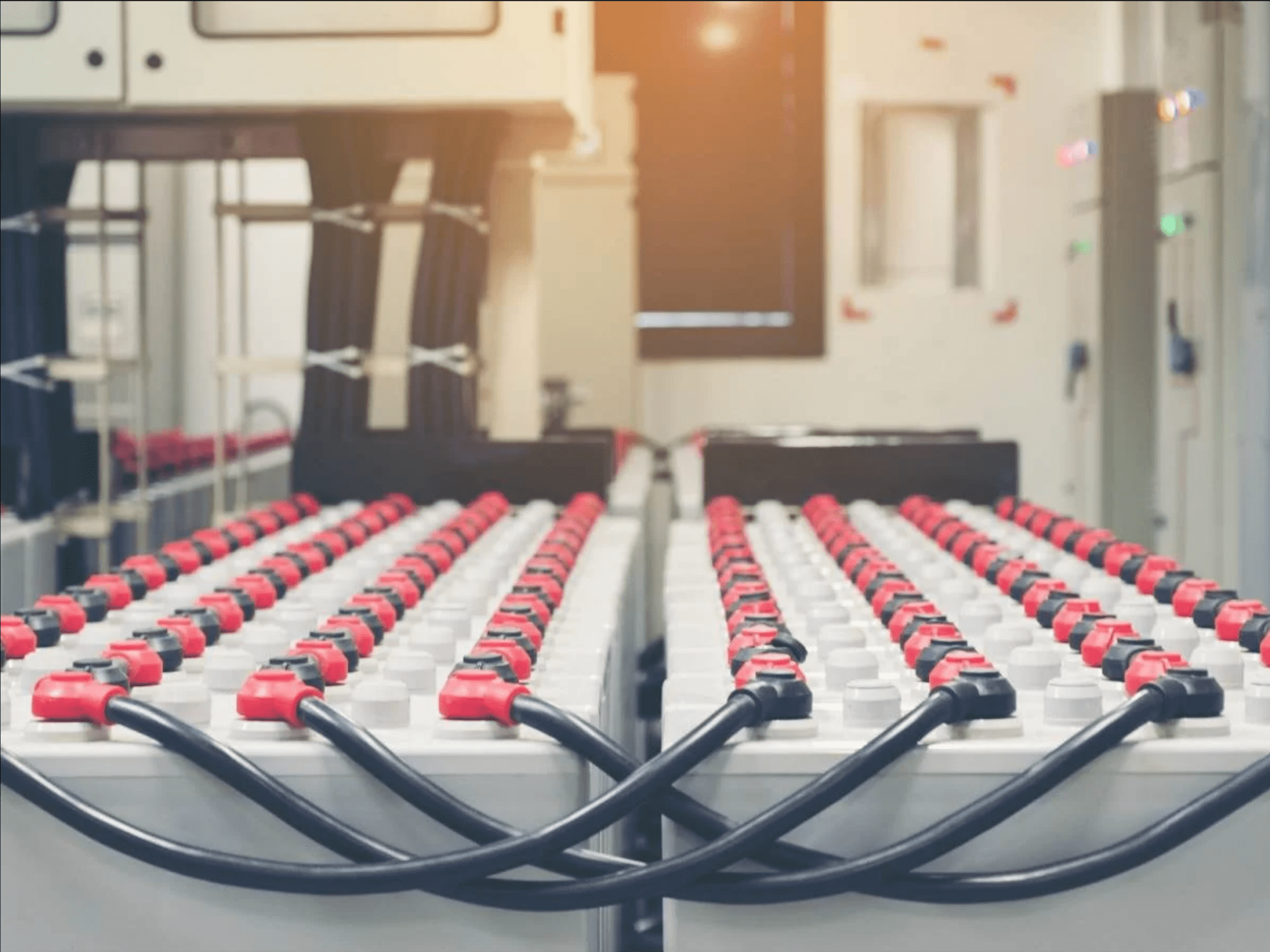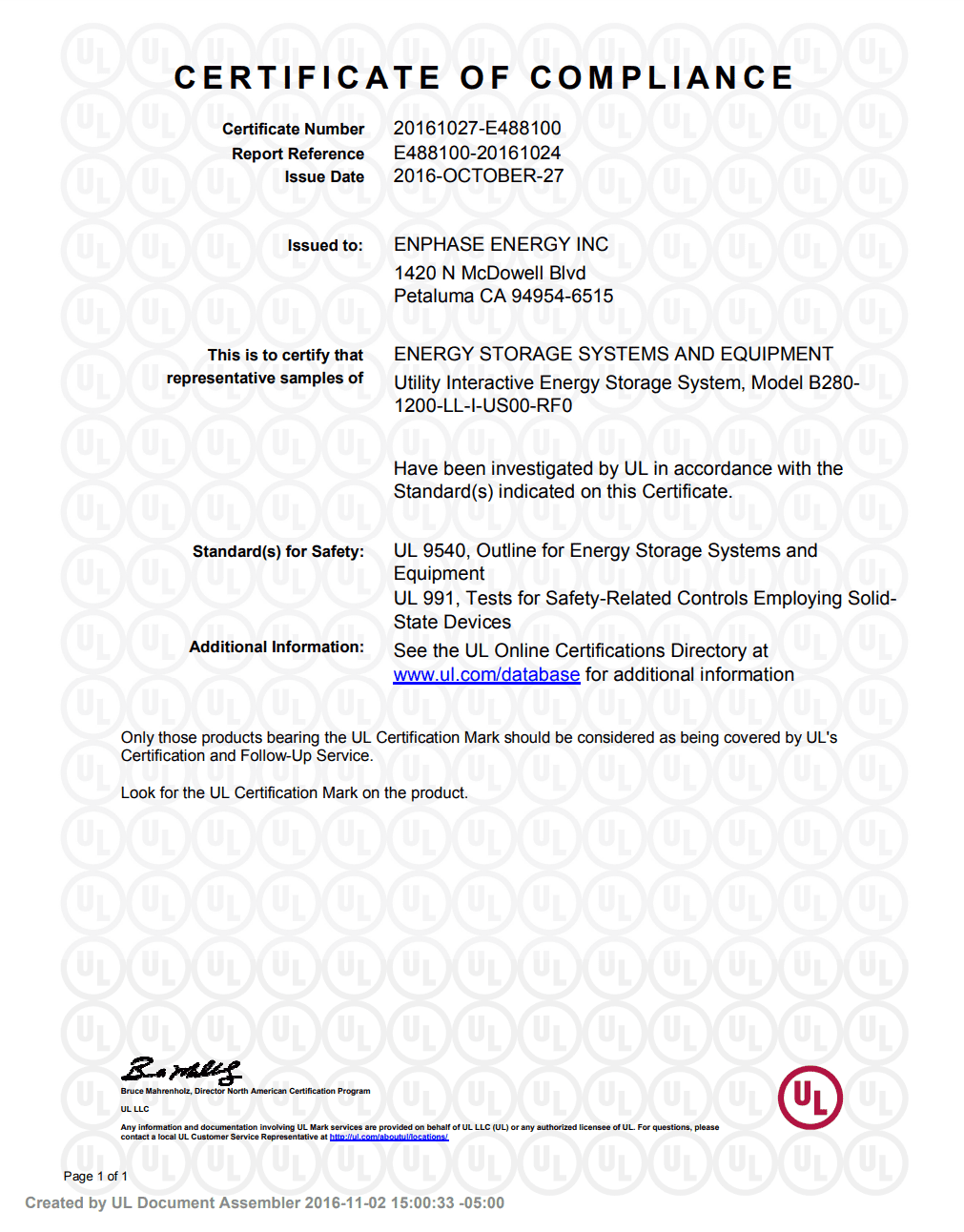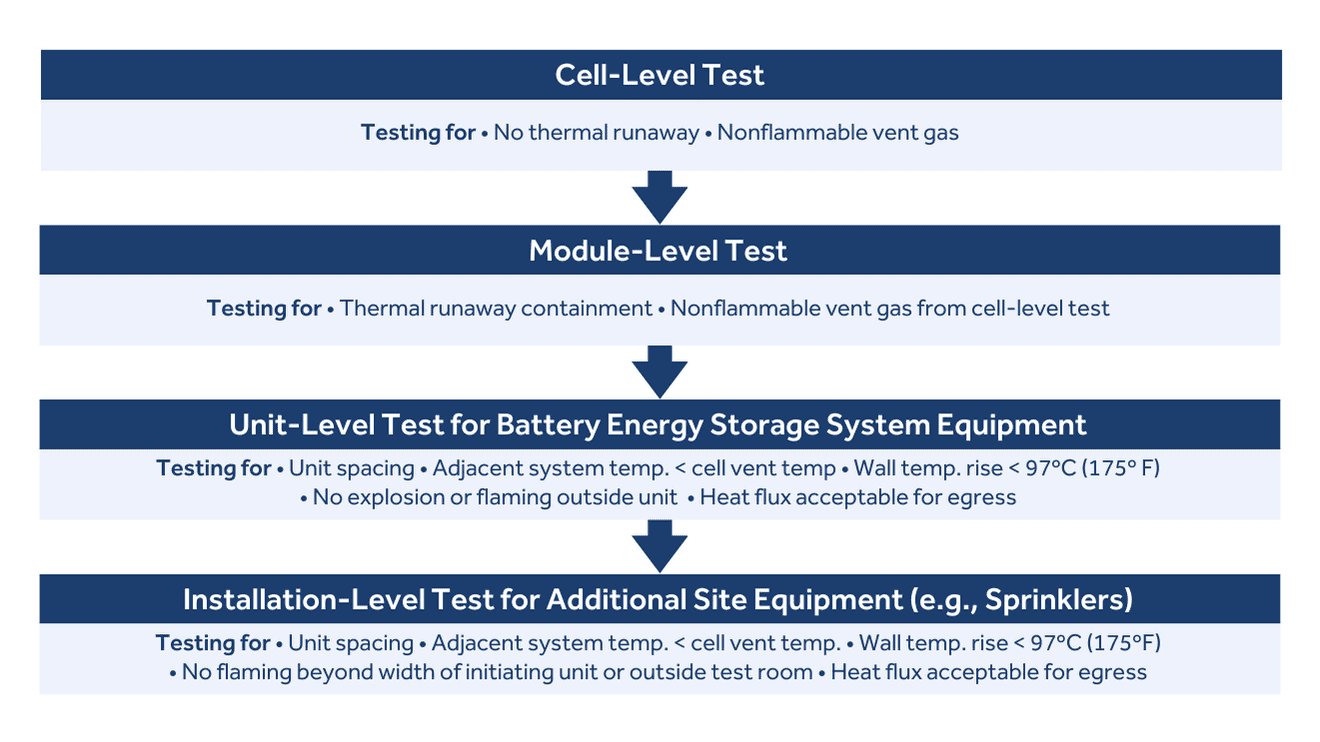
Technical Article
UL 9540 and 9540A Explained
In 2018, the California Solar Energy Industries Association (CALSEIA) rebranded to become the California Solar and Storage Association (CALSSA). Their justification was simple, it was a move that “recognizes solar’s central role in the future of the U.S. electricity generation mix while acknowledging its next evolution is inextricably intertwined with the increased use of energy storage.” Other organizations and events were quick to follow suit. For example, the annual Solar Power International conference now goes by a more nebulous name, “RE+.”
Rebrands and name changes explicitly acknowledged that solar's value to the electrical grid is fully realized when paired with energy storage. A solar-plus-storage system is no longer constrained by intermittency: electricity generated during peak sun-hours can be stored locally and exported to the grid during periods of high demand and low supply. Clean power from solar suddenly becomes accessible around the clock.
As battery costs decline and grid reliability issues persist, attachment rates (the rate at which solar PV systems are installed with energy storage) are going up. And as deployment increases, so does the intensity with which we scrutinize battery safety. That brings us to the topic of this article, UL 9540, a safety standard for the construction, manufacturing, and performance testing of grid-tied energy storage systems (ESS). UL 9540 is the measuring stick for ESS safety in the U.S. In the sections that follow, we’ll cover how products receive UL 9540 certification, what’s included in the standard, and the details of the 9540A test process.

What is UL 9540 listing?
Underwriters Laboratories (UL) authors testing, certification, and inspection standards. In 2016, UL introduced the first edition of UL 9540 as the Standard for Safety of Energy Storage Systems and Equipment. Since then, the International Fire Code (IFC), International Building Code (IBC), and NFPA 1 and NFPA 855 fire codes have all required that electrochemical ESS be listed to UL 9540.
2023 NFPA 855
15.2 Equipment Listings. ESS shall be listed and labeled in accordance with UL 9540.
The standard defines electrical, mechanical, fluid containment, environmental performance, and system safety tests for energy storage systems. Note that this is a system-level standard, meaning that all components that make up an ESS must be tested together. If an ESS were comprised of a battery (listed to its component-level standard, UL 1973) and a battery inverter (listed to yet another standard, UL 1741) packaged and designed to work together as an energy storage system, they must be tested and listed as such. This ensures that safety is retained at an integrated system level.

To demonstrate UL 9540 compliance, a manufacturer must go through one of the many Nationally Recognized Testing Laboratories (NRTLs). NRTLs that are authorized to test components to this standard can issue a certificate of compliance. All NRTLs must adhere to the UL 9540 standard when testing.
The second edition of UL 9540, in effect since July 2022, added a few new listing requirements.
- Listed ESS must be housed in a metallic enclosure.
- Listing acceptance criteria must be reflected in installation instructions. The installation manual must call out details such as ESS unit spacing limitations and other parameters derived from test results.
- Listed systems must meet the performance criteria of a new test method, UL 9540A, if the anticipated installation exceeds the capacity or unit spacing limitations described in the UL 9540 standard. More on that in the following section.
The third edition of UL 9540 was released in April 2023 and will go into effect in September 2024. Since requirements are evolving, when and to which edition an ESS was listed matters. Manufacturers will sometimes provide listing documentation on their website and, in most cases, will share documentation upon request. NRTLs will also maintain databases that include the specifics of the listings for various products.
What is UL 9540A testing?
UL 9540A is a test method to evaluate the fire safety hazards associated with propagating thermal runaway within battery systems. The tests establish that a storage technology is capable of reaching thermal runaway and then assess the fire and explosion hazards of that technology. Can we drive it into thermal runaway? If so, then what happens?
Thermal runaway occurs when a chemical reaction has gotten out of control and can no longer safely dissipate excess heat. Thermal runaway can be caused by internal short-circuits, overcharging, physical damage to cells, or high- and low-temperature environments.
The UL 9540A test method starts at the cell level and gradually builds to the installation level over four steps. If an ESS technology meets the performance criteria of any of the first three tests, there is no requirement to continue testing the subsequent levels. If not, it moves to the next level.
Cell-Level Tests
Tests start at the smallest level possible. Per UL, very few technologies meet the cell-level performance criteria: can the cell be driven into thermal runaway after multiple attempts with multiple methods? The testing stops here if there is no observable flaming, smoke, or gas venting.
Module-Level Tests
Cells are assembled into modules and retested. Now, the goal is to force propagation between one or more cells within the module and look for external flaming, smoke, or heat release. Any gas products are collected and analyzed. As with cell-level tests, this is a high bar to clear. In most cases, an ESS will move to the next level.
Unit-Level Tests
The ESS unit is installed without any fire suppression system in place unless one is integrated within the ESS. Many indoor and outdoor mounting configurations are tested. Performance criteria vary for each configuration and for residential vs. nonresidential systems. Residential systems must meet performance criteria at this level since we cannot assume that all homes have fire suppression. Nonresidential ESS that fail at this level continue to the final test.
Installation-Level Tests
Installation-level and unit-level test methods are very similar, but the effectiveness of fire suppression agents is now analyzed. ESS that show no signs of detonation, deflagration (combustion that propagates through a gas), flaming, or reignition after initial fire suppression will meet the performance criteria. The rest will fail and must change their technology or installation before retesting.

Once a technology meets the performance criteria, a UL 9540A test report is issued with details of the test setup, method, and results. Manufacturers are not required to make test reports readily available, but can voluntarily post some or all of their results to a free UL 9540A database maintained by UL. This is a great place to start if you’re looking for sample test reports.
Test results shall be provided to the fire code officials per fire code requirements. Therefore, if the manufacturer has not publicly posted these results, they will need to provide them upon request.
UL 9540 ≠ UL 9540A
UL 9540 defines a system-level listing standard. UL 9540A defines a specific test methodology. Despite how similar their names are, the two things are not the same and should not be conflated. There is no certification for UL 9540A. Certification to UL 9540 requires UL 9540A testing if indicated by the codes your AHJ follows.
Remember, different editions of the UL 9540 standard have different requirements. Most notably, ESS listed under the first edition of UL 9540 were not required to complete UL 9540A testing. Most ESS manufacturers will list compliance with UL 9540 and UL 9540A on datasheets to avoid confusion.
Data from the tests is used to determine whether an ESS can bypass the baseline safety and installation requirements ascribed by NFPA 855. For example, ESS units listed to UL 9540 that meet UL 9540A performance criteria may, in some cases, be installed closer together than non-tested units.
2023 NFPA 855
15.3.1 ESS Spacing. Individual ESS units shall be separated from each other by a minimum of 3 ft (914 mm) unless smaller separation distances are documented to be adequate based on fire and explosion testing complying with 15.13. (UL 9540A)
For a more detailed look at UL 9540A testing to bypass NFPA 855 requirements, check out our self-paced online workshop 2023 NFPA 855 and Fire Codes for ESS.
Conclusion
The solar industry is quickly becoming the solar-plus-storage industry. Meanwhile, most energy storage manufacturers sell integrated ESS (battery plus charge controller plus inverter, etc.) instead of standalone batteries. System-level listing standards like UL 9540 are proof of concept for AHJs and installers to trust that the many components that form an ESS will work together safely. System-level tests like UL 9540A define any additional fire suppression or installation requirements for ESS units.

